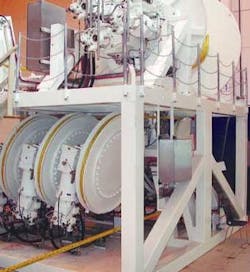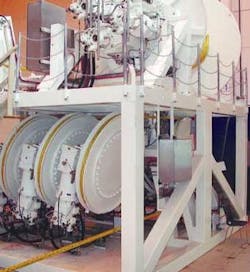New tools and technology for the offshore industry
Deepwater fiber rope deployment system
Traditional materials used as lifting or mooring lines in deepwater exploration and production are steel chain and wire. These materials have limitations, particularly in deepwater, primarily due to their weight. For example, a very large winch system must be in place to hoist the steel wire itself – the weight of the steel doubles the winch power consumption at >2,000 m water depth. Also, smaller vessels may not support the weight of the steel wire.
Whereas the rope has no limitations with respect to water depth and represents no impact on size and weight (only size of storage winch), the steel wire causes a substantial increase in weight, diameter, power-consumption, and eventually size of the handling gear as water depth increases.
Although fiber ropes have been and are still used extensively in deepwater, the loads tend to be very low. The challenge has been to develop a suitable rope construction and material combination that will overcome some of the specific problems associated with deploying large bodies into deepwater. These include the effect of constant bend over sheave cycling. As a result, there have been a number of initiatives to investigate the use of fiber ropes as a replacement for steel in deepwater operations.
Honeywell's Specialty Materials division, the makers of Spectra fiber, along with Celanese and The Cortland Co. have focused on this problem for the last three years. During this period, substantial testing of materials and constructions has resulted in the development of a new type of rope braid optimized for bending (BOB). BOB is made up of a blend of Honeywell's Spectra fiber and Vectran fiber from Celanese. The combination of fibers and special coatings has been designed to endure repeated flexing around rotating sheaves. The 12 x 12 braid blends another fiber into select sections of the rope. The rope can be made any length without the need for large splices. It can be repaired in the field, has zero torque, and has high-strength translation efficiency, the company says.
null
Although there is now a suitable fiber rope designed specifically for deepwater lifting, the next challenge is how to best handle the rope. Conventional winch systems have been designed for use with steel wire. There are two major differences in the properties of fiber ropes compared to steel wire that need to be considered when developing a fiber rope handling system: a very low coefficient of friction, and rope elongation with load. Careful consideration needs to be given to these differences, or the fiber ropes will slip on the winch sheaves, resulting in severe wear and premature failure, the company says.
Like the development of fiber ropes, there are a number of industry initiatives to develop suitable winches for fiber ropes.
Winches can be categorized into three groups: drum, capstan, and two-drum traction winches. Each winch type has specific limitations when used with fiber ropes. Drum winches store the ropes at their working load, which can result in premature damage to the rope. Also, if care is not taken, very high flange pressures can result in catastrophic failure of the drum winch. Capstan winches rely on de-tensioning the rope over multiple wraps around the capstan. The change in rope length during the de-tensioning process results in slippage on the drum surface, which causes heat build-up within the rope. Traction winches suffer from the same problems, although the careful use of controlled back tensions can minimize this problem.
Norwegian company ODIM ASA has developed the cable traction control unit (CTCU) technology. The recently built-for-purpose ODIM CTCU winch was designed to match the rope properties and, among other features, prevents the rope from slipping against the traction sheaves caused by the elongation of the fiber rope under load. The CTCU also includes active heave compensation as an integral part of the system. This technology has been workshop tested and barge tested in 100 m of water, using various dimensions of BOB rope.

